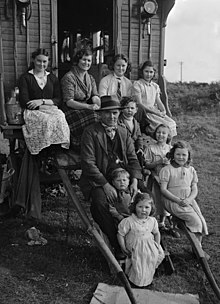Kale (Welsh Romani)
Kalé, Kalá, Valshanange | |
|---|---|
 A Kalé family in Bala, Wales, 1951 | |
| Total population | |
| 700 to 1,000[1] (1991, est.) | |
| Regions with significant populations | |
| Northwestern Wales | |
| Languages | |
| Welsh, Welsh Romani and English | |
| Religion | |
| Christianity, Romanipen |
The Kale [kɑː leɪ] (also Kalé, Kalá, Valshanange; Welsh: Roma yng Nghymru, Sipsiwn Cymreig, Cale) are a Romani subgroup predominantly found in northwestern Wales, specifically in the Welsh-speaking areas. Romani have been present in Wales since the 16th century.[2]
The Kale were traditionally renowned musicians, and are reported to have introduced the fiddle to Wales.[3][4] They were also known for their distinctive styles of clothing, dance, poetry and storytelling.[3][5][6]

The Kale are closely related to Romanichal, Scottish Lowland Romani, Romanisael and Kaale.[7] They are considered part of the Gypsy (Romani), Roma and Traveller (GRT) community.[8] Romanichal are present in South Wales (in and around Cardiff, Swansea and Newport) and North East Wales (in and around Wrexham as well as in parts of Wales close to Liverpool and Chester). The Romani people can trace their origins to Northern India.[9]
Language
[edit]The Kale spoke the traditional Welsh Romani language until at least the 1950s, when the language became a pidgin language.[6][10] The traditional language was primarily composed of Sanskrit words, but among others also had Iranian, Arabic, Greek, Romanian, German and French influences.[6]
Welsh Romani is closely related to Angloromani, Scottish Cant, Finnish Kalo and Scandoromani. Originally the variants of Welsh Romani and Angloromani constituted a common Romani dialect.[11] Romani in England, Scotland, Wales, Sweden, Norway and Finland are thought to share a common ancestry from a wave of Roma who arrived in Britain in the 16th century.[12]
Culture
[edit]
Kale traditionally participated in regional and national eisteddfodau. John Robert Lewis, the husband of Abram Wood's granddaughter, would win prizes for harping in 1842, 1848, and 1850.[13] Another descendant, John Roberts (1816–1894),[14] earned the sobriquet "Telynor Cymru", and taught his whole family various instruments. His illustrious career culminated in a performance before Queen Victoria at Palé Hall in Llandderfel near Bala on 24 August 1889, on the occasion of the Royal Visit to Wales. John Roberts played with his nine sons, all of them on the harp.[15] The Kale often adopted Welsh surnames.[6]
Traditionally, the Kale were nomadic, living in wagons and tents. Each tribe was headed by a sero rom.[6]
Many Kale claim to be descendants of Abram Wood, who settled in Wales in the early 18th century.[16]
See also
[edit]Notes
[edit]- ^ Jarman, Eldra; Jarman, A. O. H. (1991). The Welsh Gypsies : Children of Abram Wood (1st ed.). Cardiff: University of Wales Press. ISBN 9780708311066. cited in Clark, Colin Robert (2001). Invisible Lives': the Gypsies and Travellers of Britain (PDF) (PhD). University of Edinburgh. p. 109.
- ^ Cheal, Yvonne (August 2012). "Beyond the Stereotypes: A review of Gypsies/Roma/Travellers and the Arts in Wales" (PDF). Romani Cultural and Arts Company. p. 24.
- ^ a b "Welsh Romani". Curious Clwyd. Retrieved 2024-07-21.
- ^ "Clera - The Fiddle". www.clera.org. Retrieved 2024-07-21.
- ^ "Pride in Welsh Kale Gypsies' contribution to Wales glows with the inclusivity of storytelling, poetry, harp music and clog dancing". Travellers Times. Retrieved 2024-07-21.
- ^ a b c d e "Welsh Gypsy, Welsh Gypsies, Welsh Romanies, Kale, Wales". www.valleystream.co.uk. Retrieved 2024-07-21.
- ^ "International Traveller and Roma Day 2019". Parish of the Travelling People. Retrieved 13 July 2020.
- ^ Acton, Thomas; Acton, Jennifer; Cemlyn, Sara; Ryder, Andrew (2016). "Why we need to up our Numbers Game: A non-parametric approach to the methodology and politics of the demography of Roma, Gypsy, Traveller and other ethnic populations" (PDF). Radical Statistics (114). Retrieved 7 January 2024.
- ^ Marinov 2020, p. 31.
- ^ Brooks, Simon (2021) Hanes Cymry. University of Wales Press.
- ^ Sampson. J. (1926) The Dialect of the Gypsies of Wales. Oxford: Clarendon Press.
- ^ Bakker (1997) Review of McGowan, The Winchester Confessions, Journal of the Gypsy Lore Society, Fifth series 7(1): 49-50.
- ^ "Welsh Gypsy, Welsh Gypsies, Kale, John Roberts, Telynor Cymru". www.valleystream.co.uk. Retrieved 8 July 2021.
- ^ Griffith, Robert David (1959). "ROBERTS, JOHN (Alaw Elwy, also called ' Telynor Cymru '; 1816 - 1894), harpist". Dictionary of Welsh Biography. National Library of Wales. Retrieved 9 November 2017.
- ^ Roberts, E. Ernest (1978). John Roberts, Telynor Cymru (in Welsh). Dinbych: Gwasg Gee. OCLC 4957891.
- ^ "Welsh Gypsy, Welsh Gypsies, Kale, Wales". Archived from the original on 2008-06-21. Retrieved 2008-06-10.
References
[edit]- The Welsh Gypsies: Children of Abram Wood, Eldra Jarman, A. O. H. Jarman, University of Wales Press, 2011, ISBN 978-0708323984
- Marinov, Aleksandar G. (2020). Inward Looking: The Impact of Migration on Romanipe from the Romani Perspective. Romani Studies. New York Oxford: Berghahn. ISBN 978-1-78920-362-2.
